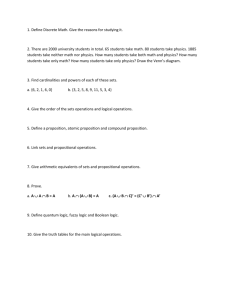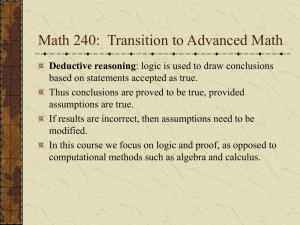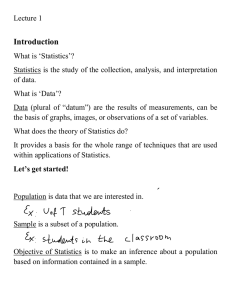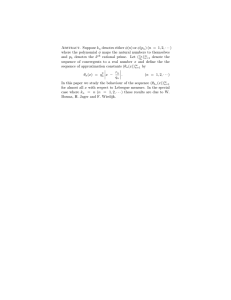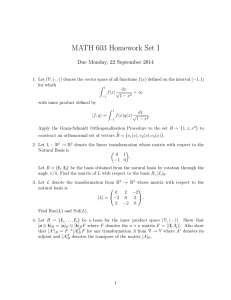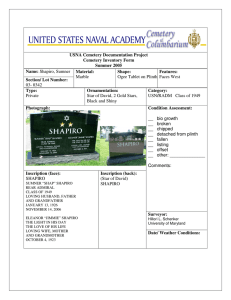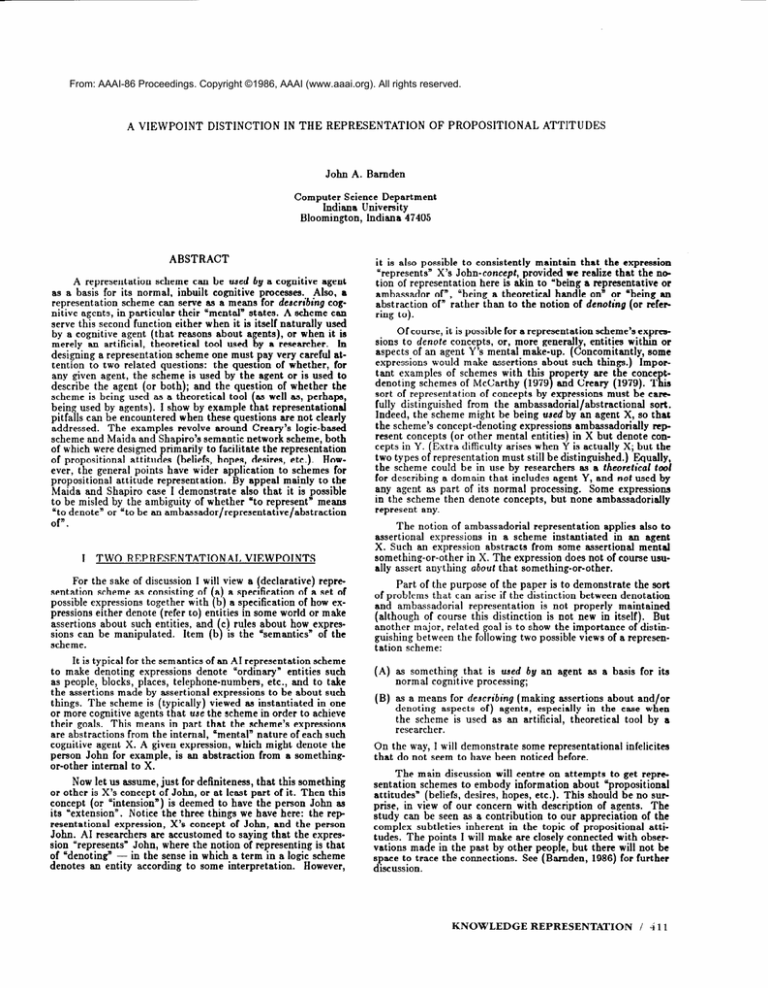
From: AAAI-86 Proceedings. Copyright ©1986, AAAI (www.aaai.org). All rights reserved.
A VIEWPOINT
DISTINCTION
IN THE REPRESENTATION
OF PROPOSITIONAL
ATTITUDES
John A. Bamden
Computer Science Department
Indiana University
Bloomington, Indiana 47405
ABSTRACT
A representation
scheme can be used by a cognitive agent
as a basis for its normal, inbuilt cognitive processes.
Also, a
representation
scheme can serve as a means for describing cognitive agents, in particular their ‘mental” states. A scheme can
serve this second function either when it is itself naturally used
by a cognitive agent (that reasons about agents), or when it is
merely an artificial, theoretical tool used by a researcher.
In
designing a representation scheme one must pay very careful attention to two related questions: the questron of whether, for
any given agent, the scheme is used by the agent or is used to
describe the agent (or both); and the question of whether the
scheme is being used as a theoretical tool as well as, perhaps,
being used by agents). I show by example t6 at representational
pitfalls can be encountered when these questions are not clearly
addressed.
The examples revolve around Creary’s logic-based
scheme and Maida and Shapiro’s semantic network scheme, both
of which were designed primarily to facilitate the representation
of propositional attitudes (beliefs, hopes., desires, etc.). However, the general points have wider application to schemes for
propositional attitude representation.
By appeal mainly to the
Maida and Shapiro case I demonstrate
also that it is possible
to be misled by the ambiguity of whether “to represent” means
“to denote” or “to be an ambassador/representative/abstraction
of-.
I
TWO REPRESENTATIONAL
VIEWPOINTS
For the sake of discussion I will view a (declarative) representation scheme as consisting of a) a specification of a set of
possible expressions together with t b) a specification of how expressions either denote (refer to) entities in some world or make
assertions about such entities, and c) rules about how expressions can be manipulated.
Item (bI is the “semanticsn of the
scheme.
It is typical for the semantics of an AI representation scheme
to make denoting expressions denote (Lordinaryn entities such
as people, blocks, places, telephone-numbers,
etc., and to take
the assertions made by assertional expressions to be about such
things. The scheme is (typically) viewed as instantiated in one
or more cognitive agents that use the scheme in order to achieve
their goals. This means in part that the scheme’s expressions
are abstractions from the internal, ‘mental” nature of each such
cognitive agent X. A given expression, which might denote the
person John for example, is an abstraction from a somethingor-other internal to X.
Now let us assume, just for definiteness, that this something
or other is X’s concept of John, or at least part of it. Then this
concept (or ‘intension”) is deemed to have the person John as
its uextensionn. Notice the three things we have here: the rep
resentational expression, X’s concept of John, and the person
John. AI researchers are accustomed to saying that the expression “represents” John, where the notion of representing is that
of ‘denoting” - in the sense in which a term in a logic scheme
denotes an entity according to some interpretation.
However,
it is also possible to consistently maintain that the expression
“represents” X’s John-concept, provided we realize that the nm
tion of representation
here is akin to “being a representative or
ambassador of”, “being a theoretical handle on” or “being an
abstraction of” rather than to the notion of denoting (or referring to).
Of course, it is possible for a representation scheme’s expressions to denote concepts, or, more generally, entities within or
aspects of an agent Y’s mental make-up. (Concomitantly, some
expressions would make assertions about such things.) Important examples of schemes with this roperty are the conce tdenoting schemes of McCarthy (1979p and Creary (1979). Tks
sort of representation
of concepts by expressions must be carefully distinguished
from the ambassadorial/abstractional
sort.
Indeed, the scheme might be being used by an agent X, so that
the scheme’s concept-denoting
expressions ambassadorially represent concepts (or other mental entities) in X but denote concepts in Y. (Extra difficulty arises when Y is actually X; but the
two types of representation must still be distinguished.)
Equally,
the scheme could be in use by researchers as a theoretical tool
for describing a domain that includes agent Y, and not used by
any agent as part of its normal processing.
Some expressions
in the scheme then denote concepts, but none ambassadorially
represent any.
The notion of ambassadorial representation
applies also to
assertional expressions in a scheme instantiated
in an agent
X. Such an expression abstracts from some assertional mental
something-or-other
in X. The expression does not of course usually assert anything about that something-or-other,
Part of the purpose of the paper is to demonstrate the sort
of problems that can arise if the distinction between denotation
and ambassadorial
representation
is not properly maintained
(although of course this distinction is not new in itself). But
another major, related goal is to show the importance of distinguishing between the following two possible views of a representation scheme:
(4
as something that is used by an agent as a basis for its
normal cognitive processing;
(B) as a means for describing (making assertions about and/or
denoting aspects of) agents, especially in the case when
the scheme is used as an artificial, theoretical tool by a
researcher.
On the way, I will demonstrate some re resent at ional infelicites
that do not seem to have been noticed g efore.
The main discussion will centre on attempts to get representation schemes to embody information about ‘Lpropositional
attitudes” (beliefs, desires, hopes, etc.). This should be no surprise, in view of our concern with description of agents. The
study can be seen as a contribution to our appreciation of the
complex subtleties inherent in the topic of propositional attitudes. The points I will make are closely connected with observations made in the past by other people, but there will not be
space to trace the connections. See (Barnden, 1986) for further
discussion.
KNOWLEDGE
REPRESENTATION
/ 4 11
My main examples of difficulties arising in representation
schemes come from the work of Maida & Shapiro 1982) and
of Creary (1979). Before going on to this, it is wort 6 pointing
out one or two preliminary examples of how the ambiguity of
‘%o represent? has appeared in the literature. A first instance is
Brachman’s writings on KL-ONE (Brachman, 1979; Brachman
& Schmolze, 1985). The KL-ONE scheme is not focused on
propositional attitudes. However, in its sophisticated treatment
of conceptual structures it shows promise of being a good candidate for application to the subtle and complex issues raised by
propositional attitudes, and Brachman & Schmolze (1985) state
that the context mechanism should prove useful for propositional
attitude representation.
It is therefore with some alarm that in
a paper such as (Brachman 1979) we find, at best, severe unclarity of presentation.
On pp.34/5 of (Brachman 1979) we are told
in one breath that “Concepts” (which, note, are formal objects
in the representation
scheme) represent intensional objects, not
“extensional (world) objet ts” , while in another we are told that
Concepts represent objects, attributes and relationships of the
the domain being modelledi also, we are told that, say, that the
ARC-DE-TRIOMPHE
Individual Concept “denotes” the real
Arc de Triomphe.
Analysis of the text is difficult, because it
may be that Brachman takes “denote” to mean something different from ?epresentn , and may be using more than one meaning
for “represent” alone. However, since KL-ONE seems to have
been partly intended for use by AI programs, one is justified
in suspecting that Brachman is (in the cited paper) unclear as
to whether his representational
expressions denote concepts or
ambassadorially
represent them. This feeling is reinforced by
the use of the word “Concept” as a name for a representational
object that is claimed to represent (denote?), rather than to &
(an abstraction of), a concept or “intensional object”. The recent description of KL-ONE in Brachman & Schmolze (1985)
also uses the term ‘represent” ambiguously in places.
The noted ambiguity is analogous to one that creeps into
Johnson-Laird’s work on mental models (Johnson-Laird,
1983 .
His theory is based on the idea that our minds manipulate bot h
“propositional representations”
(natural-language-sentence-like
structures, which denote and assert in familiar ways) and structures called “mental models”. Johnson-Laird talks much of the
time as if mental models are models of proposition representations - using the term (Lmodels~ in something akin to the
model-theoretic
sense of logic. The components of models are
thus internal objects that are, presumably, to be considered as
denoted by terms in the propositional representations.
At the
same time, Johnson-Laird often talks of mental models as ‘repstates of affairs in the outside world. [For just one
resenting”
example, see Johnson-Laird,
1983:p.419).] Now, it seems most
consistent witL his general viewpoint to take him to mean that
mental models are abstractions from outside-world states of affairs, and thus to “ambassadorially”
represent them in a sense;
rather than that mental models denote, and make assertions
about, outside-world entities. However, this view is somewhat
at odds with his (more tentative) suggestions that mental models could contain propositional-style
elements, such as numerical
tokens. The point is that such a suggestion seems to imply that
a model can be partially denotative, as well as ambassadorial.
This mixing may well be what is needed - but the point is
that the issues should be made clear, and the various notions of
representation
in use should be properly distinguished.
II
THE MAIDA AND SHAPIRO
SYSTEM
Here I demonstrate
some difficulties in the semantic net
scheme of (Maida b Shapiro 1982). [See also Rapaport & Shapiro
(1984).] M ai d a and Shapiro’s proposal is in the tradition of explicitly bringing in concept-like intensions as a basis for the rep
resentation of propositional
attitudes.
Other proposals in this
general line are McCarthy (1979), Creary (1979) and Bamden
(1983). My objections to the Maida and Shapiro scheme are
probably not fatal; but it is precisely because of the scheme’s
importance and promise that it is worthwhile to point out types
of theoretical inelegance and pragmatic awkwardness that could
have been avoided.
4
12 / SCIENCE
Maida and Shapiro place much emphasis on the idea that
the nodes in their networks do not follow the usual line of rep
resenting
“extensions”,
by which they mean Yordinaryn sorts of
entities like people, numbers, etc.; rather, nodes Vepresent” intensions. Intensions can be, for instance, concepts like that of
Mike’s telephone number as such (where the %s such” indicates
that the concept in some sense includes the characterization
of
the number as the telephone number of Mike), or a propositional
concept like that of Bill dialling Mike’s telephone number. The
question now is: which of the two types of representation
are
they appealing to ? If their John node merely represents X’s
John-concept in the ambassadorial sense, then it denoted John.
But Maida & Shapiro (1982: p-296) say ezplicitly that they ore
deporting from the idea of nodea denoting ordinary objects like
John.
So, we have to assume that they mean that the John
node actually denotes the John concept via the scheme’s seman-
tic function, and does not denote John himself - more generally,
that the universe of discourse of their scheme is just the world of
their chosen agent X’s concepts, so that the semantic function
of the scheme maps nodes to such concepts.
On the other hand, Maida and Shapiro want their networks
to be used by artificial cognitive agents, not just to serve as
a theoretical tool, and there are strong signs that Maida and
Shapiro really think to an important extent of their network
nodes as am6assadorially representing intensions. On p.300/301
of (Maida & Shapiro 1982) we read about a hypothetical robot in
which there are connections between network nodea and sensors
and effectors. On p.319 of that paper, nodes are talked about
as if they are in cognitive agents rather than just being items
in a theory about the cognitive agents. To give the authors the
benefit of the doubt we could say that they are, merely, loosely
talking about nodes when what they really mean to talk about
is the mental entities denoted by those nodes. If so, we might
have expected an explicit caveat to this effect.
Maida and Shapiro’s use of the verb Yo model” is also suspect. They say in (1982: p.296) that they want their networks to
model the belief structures of cognitive agents. It is this desire
that is the motivation for their adopting the ‘intensional” view
whereby nodes represent intensions. They failed to notice that a
conventional network that ambassadorially represents agent X,
but denotes ordinary things in the world, doea model the belief
structure of X. Such a network models the agent X ambassadorially while modelling the agent’s world in the denotational sense.
We now go on to see what problems arise in the Maida &
Shapiro scheme that are linked to the ambassadorial/denotational
confusion and to the distinctions between views A) and B) in
details
Section I. The treatment here is necessarily brief. hrther
can be found in (Barnden, 1985).
The proposition that John dials Mary’s telephone-number
could appear in a Maida & Shapiro network in the way shown in
Figure 1. The network is associated with a particular cognitive
agent X (“the system”). (For convenience, I simplify the form of
the networks in harmless ways, and adopt a diagrammatic notation slightly different from the one used by Maida and Shapiro.)
The John, Mary, dial and tel-num nodes in Figure 1 denote X’s
concept of John, X’s concept of Mary, X’s concept 01 dialling,
and X’s concept of the telephone-number
relation. The ‘head”
node D denotes the proposition, which is itself a concept or intension, and has a truth value as its extension. The node MTN
denotes the concept of Mike’s telephone number as such.
A.
Non- Uniform Dereferencing
Our first difficulty is to do with the semantics of the network fragment in Figure 2, which shows the way the proposition
that Bill believes that John is taller than Mary could appear.
Rather than trying to appeal to a precise semantics, I shall use
an informal, simplified approach. The proposition, denoted by
the node B in Figure 2, states a belief relationship between two
entities. We ask: what sort of entities are they? One is a person and the other is a proposition.
Notice here that the latter
entity is just the concept denoted by the TJM node, whereas
d\ofho
dial
John
Figure
M-I-N
tel-num
Mary
1
the former is the e&e&on of the concept denoted by the Bill
node. Thus, in determining what a proposition denoted by a
node states, we sometimes “dereference” the concepts denoted
by argument nodes and sometimes we do not.
This non-uniform dereferencing counts as a theoretical and
practical drawback. Theoretical, simply because it is a complication, and it has no analogue in some other powerful conceptbased propositional
attitude representation
schemes, such as
that of Creary (1979). Practical, because it forces processing
mechanisms that act on the networks to be aware of the need
to dereference in some cases but not in others. An example of
such a mechanism might be a system that translates network
fragments into natural-language
statements.
In the Figure 2 example, we do not want the language generator coming out with
a statement
to the effect that a concept of Bill believes aomething, or to the effect that Bill believes some truth-value (the
extension of the TJM proposition).
Remember that, despite their view of their networks as denoting conceptual structures in agent X, Maida and Shapiro also
seem to propose that an AI program could use their networks in
dealing with the world. Such a program, then, might need the
language-generating
mechanism of the previous paragraph.
B.
Figure
Descriptions
of ProBositiong
The complication of having certain argument positions of
certain relationships be of type “do-not-dereference”
is unwelcome, but perhaps tolerable. However, consider now the proposition that Mike’s favourite proposition is more complex than
Kevin’s favourite proposition. This sort of example, where there
are definite descriptions of propositions rather than explicit displays of them, is not considered in (Maida & Shapiro 1982), nor
indeed in most studies of propositional
attitudes, whether in
Philosophy or AI. I am merely using the ‘favourite proposition”
function as a way of generating simple examples. Other sorts
of mundane descriptions of propositions would be more important in practice (e.g. the description ‘the belief he expressed
yesterday”).
2
Figure 3 shows the network structure that would presumably be used. It is essential to realize here that MFP does not
denote Mike’s favourite proposition, but rather the concept 01
Mike ‘3 facourite
proposition
aa such. This is by analogy with
node MTN of Figure 1. Thus, MFP denotes a concept whose
extension is a (propositional) concept. Then, in saying what the
proposition denoted by node MC in Figure 3 is about, we must
dereference MFP and KFP. The relation “more-complex-than”
is like the relations ‘taller-than”
and =to dial” in that it does
not have do-not-deref argument-positions.
Figure
Bill
The Figure 3 example does not in itself cause difficulty; but
what are we to make of the task of representing the proposition that Bill believes Mike’s favourite proposition? Suppose we
were to use the structure shown in Figure 4. In saying what
the proposition denoted by node B states, we do now have to
dereference the concept denoted by the ARG2 node (i.e. MFP)
in the belief structure, in contrast to the case of Figure 2. For,
it isn’t that Bill believes the concept of Mike’s favourite proporoposition itself. The simple
sition; rather, he believes that
suggestion of having do-not-dere P argument positions is thus inadequate.
3
believe
MFP
fav-
prow
Figure
4
Flike
An alternative technique that would cope with the present
problem, as well as with the Figure 2 difficulty, is to refrain from
dereferencing just those concepts denoted by “proposition head
nodes- - nodes that send out REL arcs. This rule specifies
that the hlFP and KFP concepts in Figs. 3 and 4 should be
dereferenced, but not the TJM concept in Figure 2. But we
now get into trouble with the proposition that Kevin’s favourite
proposition is that John is taller than Mary. The structure in
Figure 5 is not satisfactory. The problem is that TJM denotes
the proposition that John is taller than Mary, but equally, by
analogy with the Figure 3 example, it should denote a concept
KNOWLEDGE
REPRESENTATION
/ -f 13
I
John
taller
Mary
fav-
Kevin
prow
Figure
Figure
5
other details vague, in particular the means by which node NT
denotes T and the semantics of the topmost node in the figure.
Let us assume, then, that nodes N~ill and NT are the obstractions from some cognitive structures C~;tl and CT in agent X,
where we say that CBi,l and CT are concepts that X has of the
person Bill and the proposition T.
Now suppose that we choose to design a network scheme
for describing agents such as X. Then we need a node No,,
to denote X’s concept CBill. This node is therefore similar to
the person nodes that we have seen in examples of the Maida
and Shapiro system. But, similarly, we also need a node N& to
denote X’s concept CT of the roposition T. This node is not
like the Maida and Shapiro no s e TJM in Figure 5. Node TJM
denotes the proposition T itself, whereas our N& denotes CT.
If Maida and Shapiro wanted to build a scheme whose nodes
denoted only intensions, they should perhaps have built a scheme
containing nodes like N&. That they did not can be explained
that what they really had at the back of their minds in considering propositions like “Bill believes that John is taller than
Mary” was an ambassadorial representation
structure such aa
the ooze in Figure 6. The trouble is that in adopting their intensiona! view they “lifted Bill up by one intensional level” [they
introduced a node denoting an intension for Bill] but failed to
lift proposition T up by an intensional level [introduce a node
denoting an intension for that proposition].
6
It is the systematic confusion of U with Cu for propositions
U that is at the root of the difficulties for Maida and Shapiro.
We can see this by supposing that in Figure 2 node TJM is now
taken to denote a concept ofthe proposition T that John is taller
than Mary, rather than T itself. Then in determining what the
structure in the figure is saying we have to dereference both
argument, nodes of node B, not just one. This dereferencing in
belief subnets then removes the difficulties we encountered with
the example of Figure 4.
of some proposition., because it is the ARG2 node of a favouriteproposition-of predication.
In Barnden (1985) I comment on the difficulties that would
arise in an attempt to avoid the above problems by deploying an
explicit dereferencing operator, or by having FPK’s ARG2 node
(see Figure 5) go to a node different from TJM but related to it
by the Maida and Shapiro EQUIV facility.
C.
The Source of the Difficulties
Although Maida and Shapiro tried to design a scheme in
which the denoting expressions always denote concepts, they
were strongly though unintentionally
influenced by the more
typical idea of a scheme that ambassadorially
represents concepts. They correctly realized that a representation scheme able
to cope with the representation of agents’ propositional attitudes
can be achieved by having representational
items that denote intensions (concepts with the form, for instance, of propositions
and definite descriptions).
The same basic idea has appeared in
other systems, such &s the predicate-logic schemes of McCarthy
(1979) and Creary (1979). However, each of these other schemes
was ezpzplicitlyproposed for uBe by a cognitive agent, with the denoting items in the scheme denoting people, numbers and so on
as well as intensions.
Assume in fact that we were to design a semantic-network
scheme along these more conventional lines. Suppose that the
agent X using the scheme is entertaining the proposition that
Bill believes that John is taller than Mary. Agent X could then
contain a cognitive structure P whose semantic network formulation or abstraction is depicted in Figure 6. Notice carefully
that the node labelled “NB;[~” denotes Bill himself now, not an
X-concept of him, so that it is unlike the Bill nodes in previous
figures. Equally, node Nbc[ieac denotes the relation of believing
itself! not an X-concept of it. On the other hand, the nod,e NT
is akin to a Maida and Shapiro proposition node in that It denotes the proposition T that John 1s taller than Mary. I leave
414
/ SCIENCE
III
SOME SUBTLE IMPUTATIONS
Creary (1979) has proposed a neo-Fregean way of using logic
to represent propositional attitudes. The proposal is a develop
ment of one by McCarthy (1979). In the intended inte retation
of Creary’s system, terms can denote propositional an ‘s descrip
tiona! concepts as well as “ordinary” things.
Assume that agent X is using Creary’s scheme as a represention medium and translates inputed English sentences into
expressions in the scheme. Then X will systematically impute
probably-incorrect conceptual atructurea to other agents, in a subtle way. Suppose X receives the sentence
((Sl))
M ike b e Iieves that Jim’s wife is clever.
The simplest Creary rendering
“de-ditto” fashion) is
w9
believetmike,
of this sentence
(reading it in a
Clever(Wife(Jim))).
The symbols j im and mike denote the people Jim and Mike. The
symbol Jim denotes a particular (apparently standard) concept
of the person Jim. The symbol Wife denotes a function that
when applied to some concept c of some entity delivers the (descriptiona!) concept of “the wife of [that entity as characterized
by 4” as such. Thus the term Wif e(Jim> denotes a complex,
descriptional concept. The symbol Clever denotes a function
that when applied to some concept c of some entity delivers
the propositional concept of “[that entity, aa characterized by c]
being clever”, as such. The believe
predicate is applied to a
person and to a propositional concept.
Note that the intuition underlying the use of the Clever
and Wife functions in the formula is that Mike’s belief is in
some sense couched in a direct way in terms of wife-ness and
cleverness. Notice on the other hand that the formula embodies
no claim that Mike conjures with entities representing the functions denoted by the Creary s mbols Clever and Wife. The
Clever and Wife functions are Tso far at least) merely tools the
agent X uses to ‘mentally discuss~ Mike.
the scheme is introducing imputations, or, if you like, is slipping
in important theoretical assumptions about the psychology of
agents by a back door. These assumptions may be over and
above the ones the theorist was aware of making.
However, suppose now that X inputs the sentence
e 1ieves that Mike believes that Jim’s wife is
A major Creary interpretation
W))
believe(g,
of (S2) is
Bel(Mike,
Clever$(Wife$(Jim$))))
Intuitively. this says that Georne has in his belief snace
1 something that’says whit (Cl says. Our point hinges on the nature
of the concepts denoted by the second-order concept terms in
the new formula.
The symbol JimS denotes a (standard) concept of a conceDt of J im. The svmbol Be1 denotes the function that . when
applied to a concept of a person and a concept of a p;opositional concept, delivers the DroDositional conceDt of that Derson
(so characte&ed)
believing-th& proposition (sb characteiized).
The term Wif e$ (Jim$> denotes a concept of the concept denoted
by Wife(Jim).
In fact, the concept denoted by Wife$( JimS)
explicitly involves the idea behind the concept-construction
function that is denoted by Wife, just as the concept
denoted by
Wife (Jim) explicitly involves the (wifeness) idea behind the
wife-delivering function denoted by wife. Similarly, the term
Clever$(Wif e$(Jim$> > denotes a concept C of the propositional concept denoted by Clever(Wife(Jim)),
where C ezplicitly involves the the idea behind the concept-construction
tion that is denoted by Clever.
junc-
The trouble then arising is that we must conclude that,
intuitively, (C2) conveys that George ‘a belief ia couched in terms
of the Clever
and Wife concept-construction
functiona.
This
is analogous to (C 1) conveying that Mike’s belief is couched
in terms of the wife-of function and cleverness pro erty. We
of S2s , whereas
now see that (C2) is a deviant interpretation
Creary makes it out to be a major plausible possi L ility. (C2) is
deviant because it takes George to be conjuring with conceptconstruction
functions that no-one except a theoretician (e.g.
Creary) could normally be expected to conjure with.
It is convenient to sum up this phenomenon as being an
to cognitive agents, of features of X’s particular
method of describing cognitive agents. X’s method uses conceptconstruction
functions like Clever and Wife; and X, probably
incorrectly, imputes the use of these functions to other cognitive
agents. This observation about Creary’s concept-construction
functions was implicit in a primitive form in (Bamden, 1983).
imputation,
The imputation problem in Creary’s system could have practical importance,
albeit at a sophisticated
level, as I show in
(Barnden, 1986). I demonstrate
there that analogous imputation issues crop up in many types of scheme - for instance,
auotational schemes somewhat on the lines of lBurdick 1982.
eerlis 1985, Quine 1981), and the B,-based situ&ion-semantics
scheme of Barwise & Perry (1983), if this is naturally extended
to deal with nested attitudes.
The above comments have had to be very brief. The matter is portrayed in much greater detail and in a wider context
in (Barnden 1986). 1 hope the comments made are enough to
suggest that the Importance of the imputations varies greatly
according to whether or not the representation
scheme at hand
is meant to be used as a theoretical tool for the description of
propositional attitudes. If this is not the intention - so that the
scheme is instead jwt meant to be used by a cognitive agent 89 a
base for its normal cognitive processing - then the imputations
may be tolerable, since the inaccuarcy of representation
that
they embody may not prevent the agent reacting appropriately
to its environment in most cases. That is, the representation
scheme could still be adequate to a heuristically acceptable degree. If, however, the representation scheme is meant to be used
as a theoretical tool, then the theorist should be very aware that
IV
CONCLUSION
To tie everything together: we saw that the importance of
imputations inherent in a scheme depends greatly on whether
the scheme is merely meant to be used by agents or is meant
to be B theoretical tool for describing agents; and the critique of
the Maida and Shapiro system shows that an intended view of
a scheme as describing an agent (perhaps because the scheme is
being used as a theoretical tool can be unwittingly and deleteriously affected by a view of t h e scheme as being used by the
agent. The considerations
of this paper have led me to devise
a propositional-attitude
representation
scheme that is relatively
free of imputation difficulties.
A preliminary sketch is to be
found in (Bamden, in press).
REFERENCES
Barnden, J.A. “Intensions As Such: An Outline.” In Prow 8th. Int.
Joint
Conf.
on Artificial
Intelligence.
Karlsruhe,
W. Germany,
August 1983.
Barnden, J. A. “Representations of Intensions, Representations as Intensions, and Propositional Attitudes.” Tech. Rep. 172, Computer Science Dept., Indiana University, Bloomington, Indiana,
June 1985.
J.A. “Imputations
and Explications: Representational Prob
lems in Treatments of Propositional Attitudes.” To appear in
Cognitive Science. Tech. Rep. 187(revised), Computer Science
Dept., Indiana University, Bloomington,
Indiana, April 1986.
Barnden,
Barnden, J.A. “Interpreting
Propositional
Attitude Reports: Towards
Greater Freedom and Control.” To appear in Prom 7th Europenn
Gonf. on Art. ht., July 1986. In press.
Barwise, J., & Perry, J. Situation8 and Attitudes. Cambridge, Mass.:
MIT Press,
1983.
Bra&man,
R.J. On the epistemological
status of semantic networks.
In N.V. Findler (ed.), Aseocintive Nelworku. New York: Academic
Press, 1979.
Brachman,
R.J. & J.G. Schmolze.
“An Overview of the KL-ONE
Knowledge Representation
System.” Cognitive Science 92 (1985)
171-216.
Burdick, II. “A Logical Form for the Propositional
these 52 (1982) 185-230.
Attitudes.”
Sgn-
Creary, L.G. “Propositional
Attitudes:
Fregean Representation
and
Simulative Reasoning.”
In Proce.
6th. ht.
hint COnf. on
Artificial Intelligence, Tokyo, Japan, August 1979.
Johnson-Laird, P.N.
Press,
Mental
Modek.
Cambridge, Mass.: Harvard Univ.
1983.
McCarthy, J. “First Order Theories of Individual Concepts and Propositions.” In J. E. Hayes, D. Michie & L. 1. Mikulich (Eds.), Mochine Intelligence 9. Chichester, England: Ellis Horwood, 1979.
Maida, A.S. & S.C. Shapiro.
“Intensional Concepts in Propositional
Cognitive Science 6:4 (1982) 291-330.
Semantic Networks.”
Perlis, D. “Languages with Self-Reference
Intelligence 25 (1985) 301-322.
I: Foundations.”
Artificial
Quine, W.V. Yntensions Revisited.”
In W.V. Quine, Theories
Things. Cambridge, Mass.: Harvard U. Press, 1981.
and
Rapaport,
W. J., k S.C. Shapiro.
“Quasi-IndexicaI Reference in
Propositional
Semantic Networks.*
In Prow 10th Int. Conf.
on Compulational Linguistics, Stanford Univ., USA, 1984.
KNdWLEDGE
REPRESENTATION
/ 4 15

